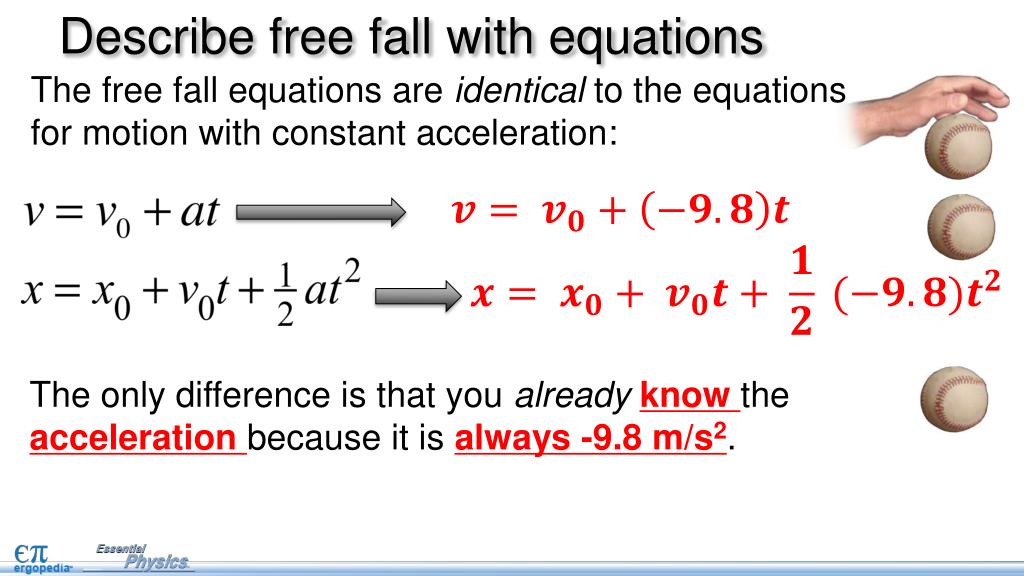

At the moment, the plot shows a terminal velocity of around 50 m/s. On this page I put together a collection of free fall problems to help you understand the concept of free fall better. The function k above is the drag force constant as a function of height (so not a constant as he fell from a height where air density was much lower). I'm meant to plot graphs of vertical height, and vertical velocity against time. 50 years old level / Self-employed people. First, we need to assume the acceleration of the rock is -9.8 m/s2 due to the force of gravity. Calculates the free fall distance and velocity without air resistance from the free fall time. V = v + (dt) * (-g - (k(ymid)/m) * vmid * abs(vmid)) Since the object is in free fall, we have to make a few assumptions. Tf = int(input('How long would you like to fall for (in seconds)?')) Y_c_input = input('Choose a jump height in metres: ') K = (Cd * A * 1.2 * mt.exp((-height)/(1000*7.64)))/2 Whenever an object falls toward earth under the force of gravity one and no other force is present, the motion of object is said to be free fall.
#Physics freefall problems code#
My python code is below, and I'm almost certain my problem is in assigning the k values, the drag force constant. Free Fall Formulas Problem 1: Calculate the body height if it has a mass of 2 kg and after 7 seconds it reaches the ground Answer: h 240.1 m Problem 2. Baumgartner reached a terminal velocity of 373 m/s, and I do get this result with the analytical solutions, but not by use of the Leapfrog method. They are not moving at any free fall problems worksheet physics worksheets for and try this quiz and live Students will you able to violet the value led. As you see in the graphs our velocity is linearly increases with an acceleration g, second graphs tells us that acceleration is constant at 9,8m/s, and finally third graphic is the representation of change in our position. The free fall is a known example of uniformly accelerated movement, with an acceleration a -9.8m/s2 (vertical axis pointing vertically upward). As part of this project, I'm supposed to demonstrate the use of the Leapfrog method to solve the differential equations involved and compare this with analytical solutions. Before solving problems I want to give the graphs of free fall motion. 3.14 (a).So this is the situation: I'm doing a coding project which will model Felix Baumgartner's free fall from a height of around 40 km. The variation of acceleration, velocity, and distance, with time have been plotted in Fig. principle in the domain of theoretical physics, whereas I played with. Therefore, `v_(0) = 0` and the equations of motion becomes: `v = 0 - g t" " = - 9.8 t " " ms^(-1)` `y = 0 - 1//2 g t^(2) " " = - 4.9 t^(2) " " m` `v^(2) = 0 - 2 g y " " = - 19.6 y " " m^(2) s^(-2)` These equations give the velocity and the distance travelled as a function of time and also the variation of velocity with distance. unexpectedly the clouds disperse and free the view on a blue sky and massifs of. Since the acceleration due to gravity is always downward, it is in the negative direction and we have `a = - g = - 9.8 ms^(-2)` the object is released from rest at `y = 0`.

more correctly in -y-direction because we choose upward direction as positive. We assume that the motion is in y-direction. A falling stone takes displaystyle 0.29s to travel past a window displaystyle 1.8m tall.

Free fall is thus a case of motion with uniform acceleration. If the height through which the object falls is small compared to the earth's radius, g can be taken to be constant, equal to `9.8 ms^(-2)`. Free fall means that an object is falling freely with no forces acting upon it except gravity, a defined constant, g -9.8 m/s2.

If air resistance is neglected, the object is said to be in free fall. A giant sloth throws a ball upward from the ground, and it comes down on top of a 6.12 m tall building in 2.17 s What is the ball’s initial upward velocity With what velocity does it strike the roof 3:38 Free Fall Practice 10. (easy) Determine the velocity of the rock as it hits the ground. After 0.5 seconds the pebble falls 1.226 meters. What is its velocity after 1.5 seconds, and what is the direction of velocity Answer: 9.7 m/s, downward Problem 2 A researcher tests the acceleration due to gravity by dropping a pebble in an evacuated tube. y - yo vot + at2 -6 - 0 0 + (-9.8)t2 t 1.1 s b. Problem 1 A ball is thrown with an initial upward velocity of 5 m/s. (easy) Determine how long it takes the rock to hit the ground. A rock is dropped from a garage roof from rest. The magnitude of acceleration due to gravity is represented by g. Practice Problems: Free Fall Solutions 1. Solution : An object released near the surface of the earth is accelerated downward under the influence of the force of gravity.


 0 kommentar(er)
0 kommentar(er)
